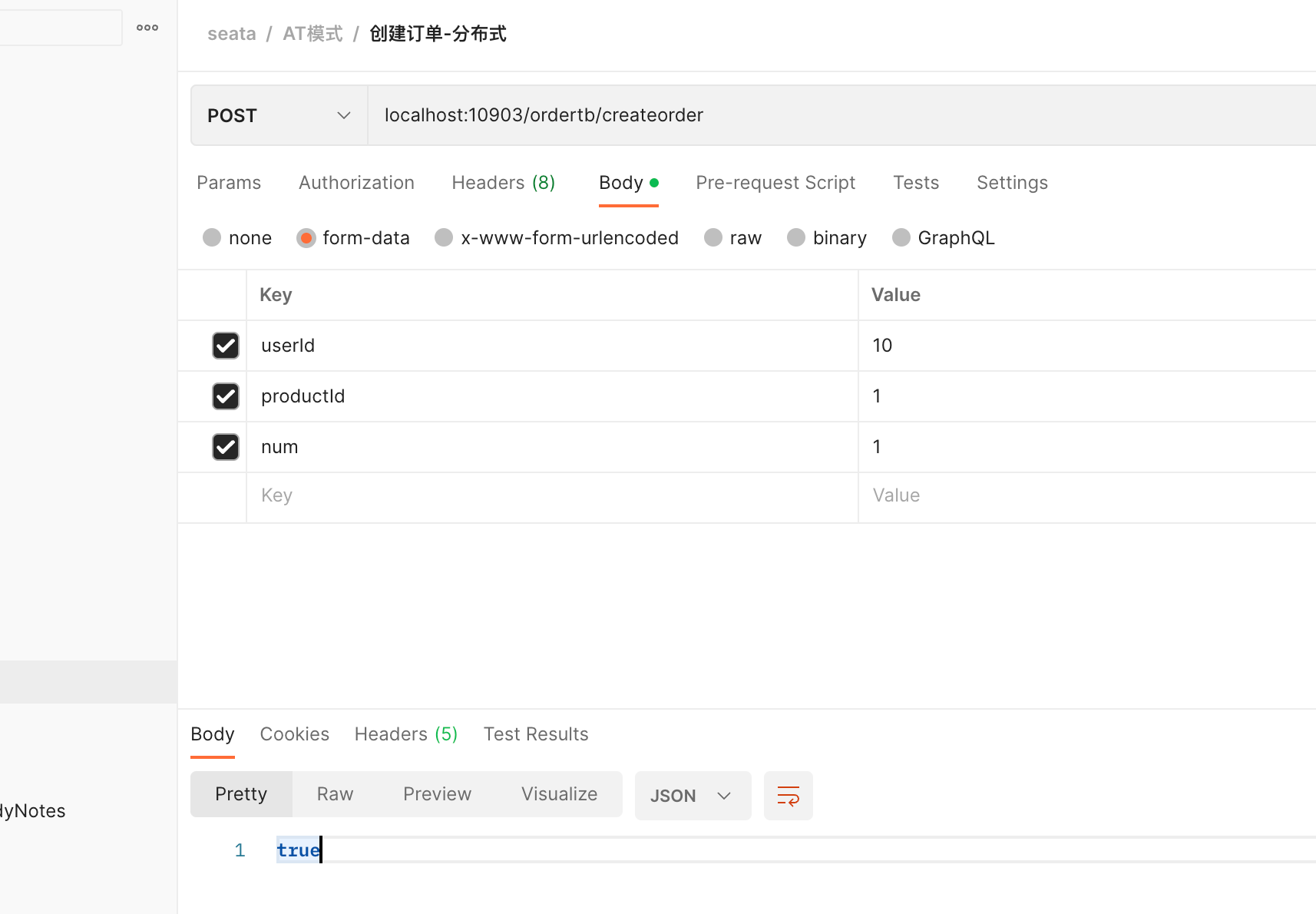使用场景
举一个简单的应用场景:电商系统中,一个用户发起购买商品的动作,后端业务逻辑是
- 扣减库存
- 扣减个人账户上的余额
- 创建一个订单
只要上面有一个步骤没有执行成功,就回滚已经执行成功的其他步骤。为了模拟分布式事务的效果,我们采用创建三个微服务的方式实现。
- seata-at-storage 库存服务
- seata-at-account 账户服务
- seata-at-order 订单服务
所以上面的业务逻辑就变成了,用户发起一个购买商品的服务,直接调用后端 订单服务 ,由订单服务分别调用 库存服务 完成扣减库存功能,然后再调用 账户服务 完成扣减账户金额功能,最后本地生成一个订单。
这里我们需要一个注册中心,把三个服务注册到上面,这样配合 OpenFeign 完成相互调用,此外我们还需要 MySQL 作为数据存储,最后我们需要 Seata 作为我们的事务管理器。
搭建 seata-at-storage 服务模块
- 先创建数据库
-- 仓储
CREATE TABLE `storage` (
`id` bigint(11) NOT NULL AUTO_INCREMENT,
`name` varchar(100) DEFAULT NULL,
`num` bigint(11) DEFAULT NULL COMMENT '数量',
`create_time` timestamp NOT NULL DEFAULT CURRENT_TIMESTAMP COMMENT '创建时间',
`price` bigint(10) DEFAULT NULL COMMENT '单价,单位分',
PRIMARY KEY (`id`) USING BTREE
) ENGINE=InnoDB DEFAULT CHARSET=utf8mb4 ROW_FORMAT=COMPACT;
CREATE TABLE `undo_log` (
`branch_id` bigint(20) NOT NULL COMMENT 'branch transaction id',
`xid` varchar(100) NOT NULL COMMENT 'global transaction id',
`context` varchar(128) NOT NULL COMMENT 'undo_log context,such as serialization',
`rollback_info` longblob NOT NULL COMMENT 'rollback info',
`log_status` int(11) NOT NULL COMMENT '0:normal status,1:defense status',
`log_created` datetime(6) NOT NULL COMMENT 'create datetime',
`log_modified` datetime(6) NOT NULL COMMENT 'modify datetime',
UNIQUE KEY `ux_undo_log` (`xid`,`branch_id`) USING BTREE
) ENGINE=InnoDB DEFAULT CHARSET=utf8 ROW_FORMAT=COMPACT COMMENT='AT transaction mode undo table';使用 idea 工具中的 initializer 工具,生成模块的骨架,这里不再赘述。
修改 pom 文件,添加上 nacos 注册中心、Mybatis、MySQL、Seata 的相关依赖。
<dependency>
<groupId>com.alibaba.cloud</groupId>
<artifactId>spring-cloud-starter-alibaba-nacos-discovery</artifactId>
</dependency>
<dependency>
<groupId>com.baomidou</groupId>
<artifactId>mybatis-plus-boot-starter</artifactId>
</dependency>
<!-- mysql -->
<dependency>
<groupId>mysql</groupId>
<artifactId>mysql-connector-java</artifactId>
</dependency>
<!--seata-->
<dependency>
<groupId>com.alibaba.cloud</groupId>
<artifactId>spring-cloud-starter-alibaba-seata</artifactId>
<exclusions>
<!-- 排除依赖 指定版本和服务器端一致 -->
<exclusion>
<groupId>io.seata</groupId>
<artifactId>seata-all</artifactId>
</exclusion>
<exclusion>
<groupId>io.seata</groupId>
<artifactId>seata-spring-boot-starter</artifactId>
</exclusion>
</exclusions>
</dependency>
<dependency>
<groupId>io.seata</groupId>
<artifactId>seata-all</artifactId>
</dependency>
<dependency>
<groupId>io.seata</groupId>
<artifactId>seata-spring-boot-starter</artifactId>
</dependency>- 修改项目的配置: application.yml
server:
port: 10902
spring:
application:
name: seata-at-storage
datasource:
url: jdbc:mysql://192.168.1.150:3306/seata_storage?useUnicode=true&characterEncoding=UTF-8&serverTimezone=Asia/Shanghai
username: root
password: root
driver-class-name: com.mysql.cj.jdbc.Driver
hikari:
auto-commit: true
connection-test-query: SELECT 1
connection-timeout: 30000
idle-timeout: 180000
max-lifetime: 0
maximum-pool-size: 30
minimum-idle: 10
pool-name: hikari-pool
cloud:
nacos:
discovery:
server-addr: 192.168.1.150:8848
namespace: 2cbceeeb-22f5-40d6-b65c-47f673e79f29
mybatis:
mapper-locations: classpath:/mapper/*.xml
# 配置日志级别
logging:
level:
root: debug- 之后再使用 idea 中的 easycode 插件生成业务代码,关键方法是:
me.zeanzai.seataatstorage.service.impl.StorageServiceImpl#deduct
@Transactional
@Override
public boolean deduct(Long id, Long num) {
//todo 模拟扣减库存,具体业务逻辑自己完善
Storage storage = this.storageDao.queryById(id);
if (Objects.isNull(storage))
throw new RuntimeException();
storage.setNum(storage.getNum()-num);
return this.storageDao.update(storage) > 0;
}搭建 seata-at-account 和 seata-at-order 服务模块
搭建过程与上面的 seata-at-storage 服务模块的过程基本类似。
seata-at-account 的表结构:
-- 账户余额
CREATE TABLE `account` (
`id` BIGINT ( 11 ) NOT NULL AUTO_INCREMENT,
`user_id` VARCHAR ( 32 ) CHARACTER SET utf8mb4 COLLATE utf8mb4_general_ci NULL DEFAULT NULL COMMENT '用 户userId',
`money` BIGINT ( 11 ) NULL DEFAULT NULL COMMENT '余额,单位分',
`create_time` timestamp NOT NULL DEFAULT CURRENT_TIMESTAMP COMMENT '创建时间',
PRIMARY KEY ( `id` ) USING BTREE
) ENGINE = INNODB CHARACTER SET = utf8mb4 COLLATE = utf8mb4_general_ci ROW_FORMAT = Compact;
CREATE TABLE `undo_log` (
`branch_id` bigint(20) NOT NULL COMMENT 'branch transaction id',
`xid` varchar(100) NOT NULL COMMENT 'global transaction id',
`context` varchar(128) NOT NULL COMMENT 'undo_log context,such as serialization',
`rollback_info` longblob NOT NULL COMMENT 'rollback info',
`log_status` int(11) NOT NULL COMMENT '0:normal status,1:defense status',
`log_created` datetime(6) NOT NULL COMMENT 'create datetime',
`log_modified` datetime(6) NOT NULL COMMENT 'modify datetime',
UNIQUE KEY `ux_undo_log` (`xid`,`branch_id`) USING BTREE
) ENGINE=InnoDB DEFAULT CHARSET=utf8 ROW_FORMAT=COMPACT COMMENT='AT transaction mode undo table';seata-at-order 服务模块的表结构:
-- 订单
CREATE TABLE `ordertb` (
`id` bigint(11) NOT NULL AUTO_INCREMENT,
`product_id` bigint(11) DEFAULT NULL COMMENT '商品Id',
`num` bigint(11) DEFAULT NULL COMMENT '数量',
`user_id` varchar(32) DEFAULT NULL COMMENT '用户唯一Id',
`create_time` timestamp NOT NULL DEFAULT CURRENT_TIMESTAMP COMMENT '创建时间',
`status` int(1) DEFAULT NULL COMMENT '订单状态 1 未付款 2 已付款 3 已完成',
PRIMARY KEY (`id`) USING BTREE
) ENGINE=InnoDB CHARACTER SET = utf8mb4 COLLATE = utf8mb4_general_ci ROW_FORMAT=COMPACT;
CREATE TABLE `undo_log` (
`branch_id` bigint(20) NOT NULL COMMENT 'branch transaction id',
`xid` varchar(100) NOT NULL COMMENT 'global transaction id',
`context` varchar(128) NOT NULL COMMENT 'undo_log context,such as serialization',
`rollback_info` longblob NOT NULL COMMENT 'rollback info',
`log_status` int(11) NOT NULL COMMENT '0:normal status,1:defense status',
`log_created` datetime(6) NOT NULL COMMENT 'create datetime',
`log_modified` datetime(6) NOT NULL COMMENT 'modify datetime',
UNIQUE KEY `ux_undo_log` (`xid`,`branch_id`) USING BTREE
) ENGINE=InnoDB DEFAULT CHARSET=utf8 ROW_FORMAT=COMPACT COMMENT='AT transaction mode undo table';扣减金额的关键代码, me.zeanzai.seataataccount.service.impl.AccountServiceImpl#deduct :
@Transactional
@Override
public boolean deduct(String userId, Long money) {
Account account = this.accountDao.queryByUserId(userId);
if (Objects.isNull(account)) {
return false;
}
account.setMoney(account.getMoney()-money);
return this.accountDao.update(account)>0;
}由于 seata-at-order 服务模块中需要使用 OpenFeign 来调用仓储和账户服务,因此还需要创建两个接口:
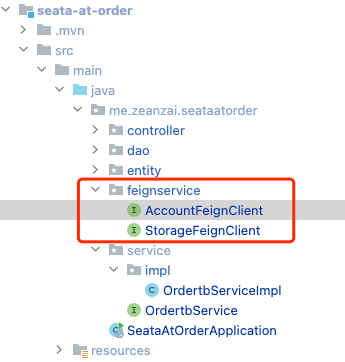
@FeignClient(value = "seata-at-account")
public interface AccountFeignClient {
@PostMapping("/account/deduct")
boolean deduct(@RequestParam("userId") String userId,
@RequestParam("money") Long money);
}@FeignClient(value = "seata-at-storage")
public interface StorageFeignClient {
@GetMapping("/storage/{id}")
ResponseEntity<Storage> queryById(@PathVariable("id") Long id);
@PostMapping("/storage/deduct")
boolean deduct(@RequestParam("id") Long id,
@RequestParam("num") Long num);
}之后就是生成订单的关键代码, me.zeanzai.seataatorder.service.impl.OrdertbServiceImpl#createOrder :
@Transactional
@Override
public boolean createOrder(String userId, Long productId, Long num) {
// 1. 扣减库存
storageFeignClient.deduct(productId, num);
// 2. 扣减余额
ResponseEntity<Storage> storageResponseEntity = storageFeignClient.queryById(productId);
Storage body = storageResponseEntity.getBody();
accountFeignClient.deduct(userId, body.getPrice() * num);
// 3. 创建订单
Ordertb ordertb = new Ordertb();
ordertb.setNum(num);
ordertb.setUserId(userId);
ordertb.setProductId(productId);
ordertb.setStatus(2);
return this.ordertbDao.insert(ordertb)>0;
}启动并测试
分别启动 seata-at-storage 、 seata-at-account 、seata-at-order 模块,我们会发现已经注册到 nacos 上了。
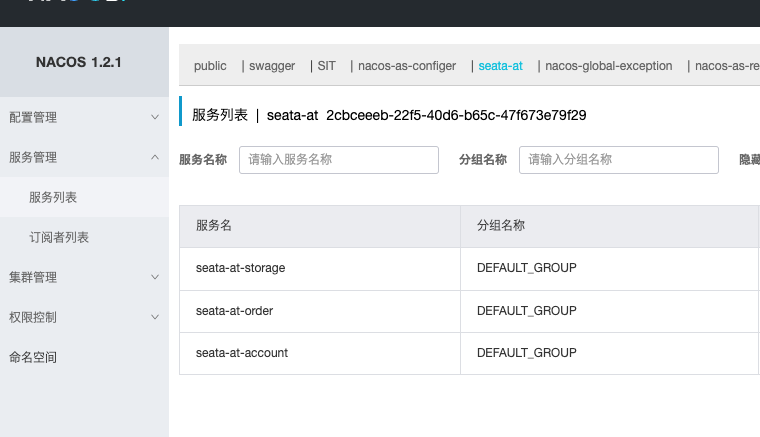
之后我们只需要调用订单模块中的 createOrder 接口就行了。
特别注意的点:三个服务模块中都只是使用@Transactional标注了本地事务,并没有开始分布式事务。
整合 Seata
直到这一步,我们跟 Seata 没有任何关系,因为我们生成订单的方法中并没有定义事务,只是简单的本地事务,在生成订单的接口中,如果扣减库存的接口出现超时等异常错误信息,扣减金额和生成订单的逻辑并不会回滚。下面我们来说整合 Seata 的过程。安装和配置 Seata 这里就不再赘述。
- 首先要先启动 Seata

- 在三个模块中分别添加 Seata 的配置
seata:
enabled: true
application-id: ${spring.application.name}
tx-service-group: ${spring.application.name}-tx-group
config:
type: nacos
nacos:
namespace: bb4ba084-9183-4406-bdf4-9254d372849e
server-addr: 192.168.1.150:8848
group: SEATA_GROUP
username: nacos
password: nacos
registry:
type: nacos
nacos:
application: seata-server
namespace: bb4ba084-9183-4406-bdf4-9254d372849e
server-addr: 192.168.1.150:8848
group: SEATA_GROUP
username: nacos
password: nacos- 创建 Seata 服务端配置,这里要特别注意:值均为 default。
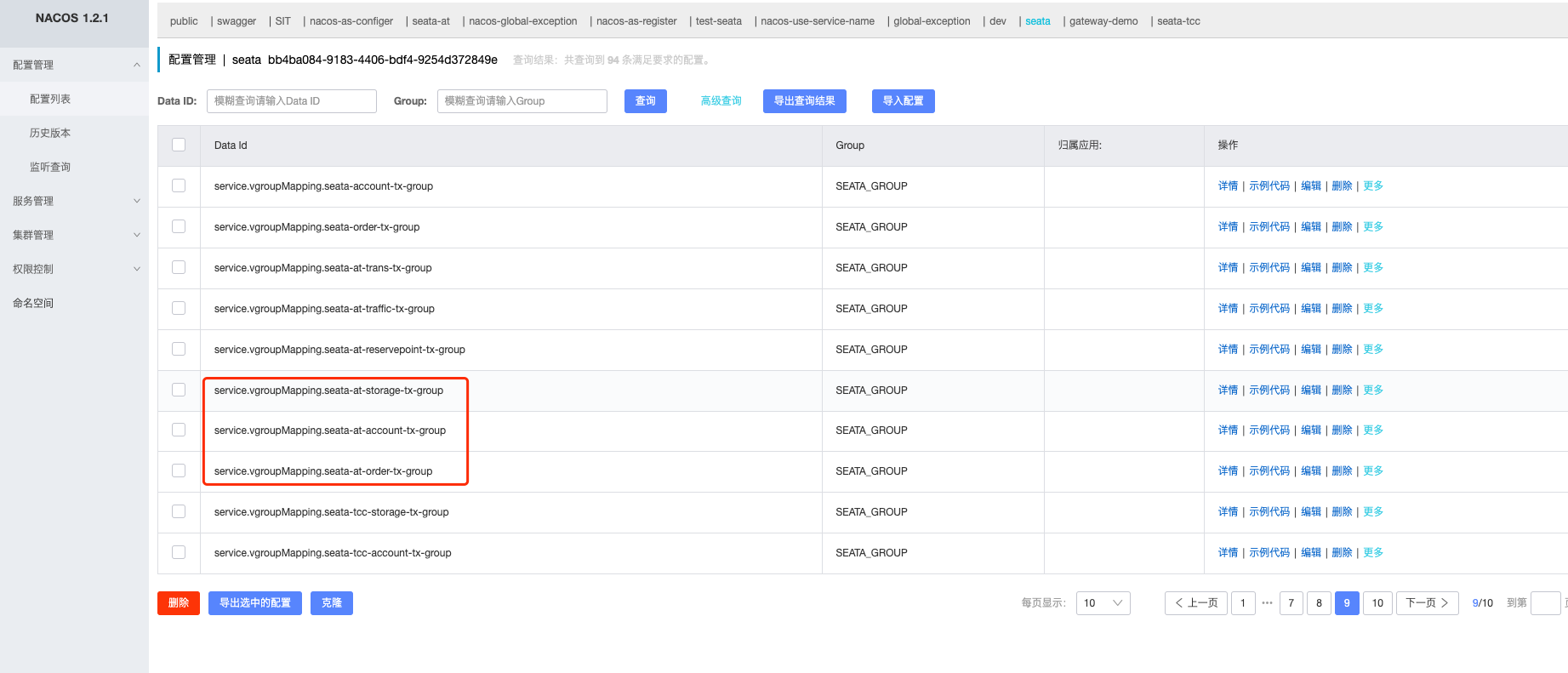
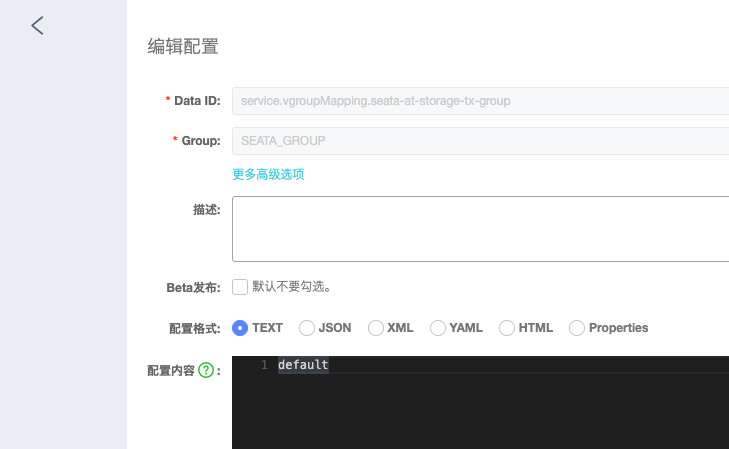
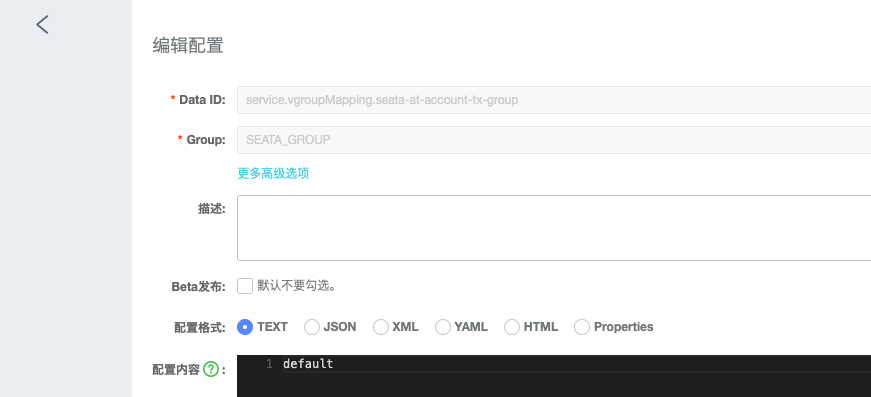
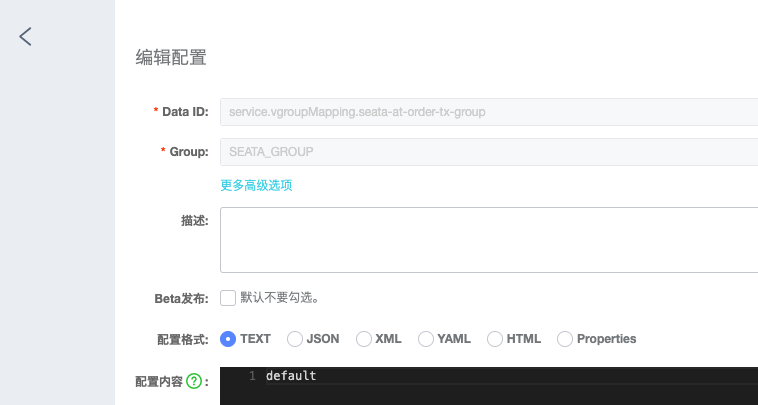
- 修改业务代码,在订单模块中设置生成订单的方法为全局事务
@Override
@GlobalTransactional
public boolean createOrder(String userId, Long productId, Long num) {
// 1. 扣减库存
storageFeignClient.deduct(productId, num);
// 2. 扣减余额
ResponseEntity<Storage> storageResponseEntity = storageFeignClient.queryById(productId);
Storage body = storageResponseEntity.getBody();
accountFeignClient.deduct(userId, body.getPrice() * num);
// 3. 创建订单
Ordertb ordertb = new Ordertb();
ordertb.setNum(num);
ordertb.setUserId(userId);
ordertb.setProductId(productId);
ordertb.setStatus(2);
return this.ordertbDao.insert(ordertb)>0;
}- 启动测试
